Halló from Iceland!
We began with a little blast from the past, 1784 to be exact. We started the day with a short trip to the ruins of the Fire Sermon Church in Kirkjubæjarklaustur. This was the church where the Fire Sermon was spoken during the Laki eruption in 1784. While here we discussed a bit about the Laki eruption itself and its effect on the town, but we also discussed the impacts that volcanoes can have on climate change. Volcanoes can change climate in two different ways. First, in the short term volcanoes can cool down the planet through the expulsion of ash and aerosols. Larger eruptions can cause drops between 1-2 degrees or even more! Second, in the long term they can warm the planet in the same way humans do through the expulsion of greenhouse gasses like carbon dioxide. Humans do this to a greater extent than volcanoes in the modern era though.
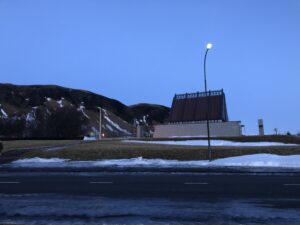
After leaving the church we found a large moraine to hike around. The view was absolutely beautiful from the top of the mound. Once we hiked to a position where we could see a glacier Jeff lectured on the different types of moraines tend to happen around glaciers. These moraine types included lateral, medial, terminal, and recessional moraines. These moraines are created on the side of a glacier, between two glaciers, at the end of a glacier, and when a glacier recedes respectively. After this we left and hiked straight up the mound to get back to the bus more quickly and we at lunch on the way to the glacier.
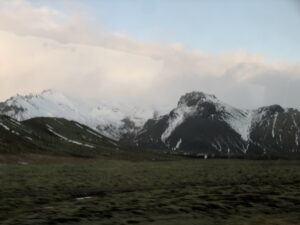
Once we reached the glacier we were early so we waited nearby and viewed the icy ocean from a black sand beach that was filled with boulder size pieces of ice, and a ridge that overlooked both the beach and ocean. This pit stop was only for a short while, but once the time came we left for the glacier.
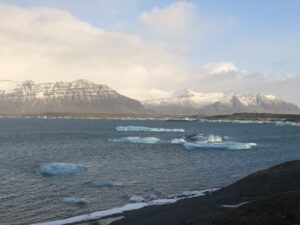
The glacier required a significant car ride to get to in which the tour guide had to deflate the tires a bit to make the ride smoother. Then we got to the caves, the nearest was named the Black Diamond, and the further cave was named the Blue Diamond. The class split into two groups and the other group left for the Blue Diamond while my group began to delve into the Black Diamond. The Black Diamond was named for the black coloration of the ice given to it by the volcanic sediment that the glacier. Due to this it also had some rocks sticking out of the ceiling, so we had to put helmets on in case of falling rocks. I was glad for the helmets though, as I bumped my head on the low ceilings a few times. The Black Diamond was beautiful throughout the walk of it. The color was amazing and the well at the end of it was the most beautiful part of the cave.
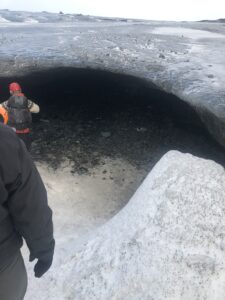
After the Black Diamond we traveled to the Blue Diamond. This cave was significantly different to the other, first it was of course blue. This difference in color is due to the lack of sediment collected by this section of glacier leaving the glacier with its natural blue coloration. The cave was also much taller and shorter than the Black Diamond, though this seemed to be a difference in formation rather than the ice itself.
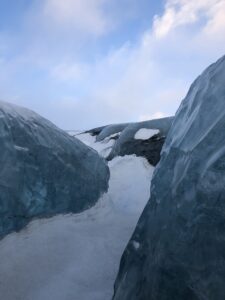
Finally, after leaving the caves and getting to the new hostel we were in for one last sight, the Aurora Borealis. Tonight was finally the perfect storm of a clear night and an active aurora that allowed our class to see the Northern Lights for the first and hopefully not last time this trip.

Leave a Reply